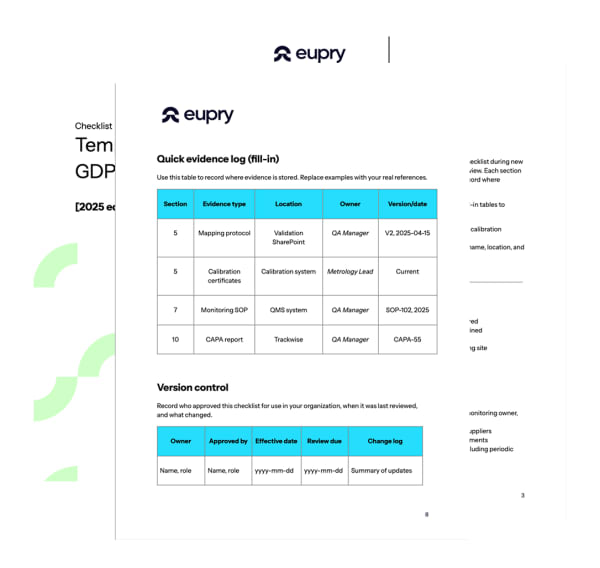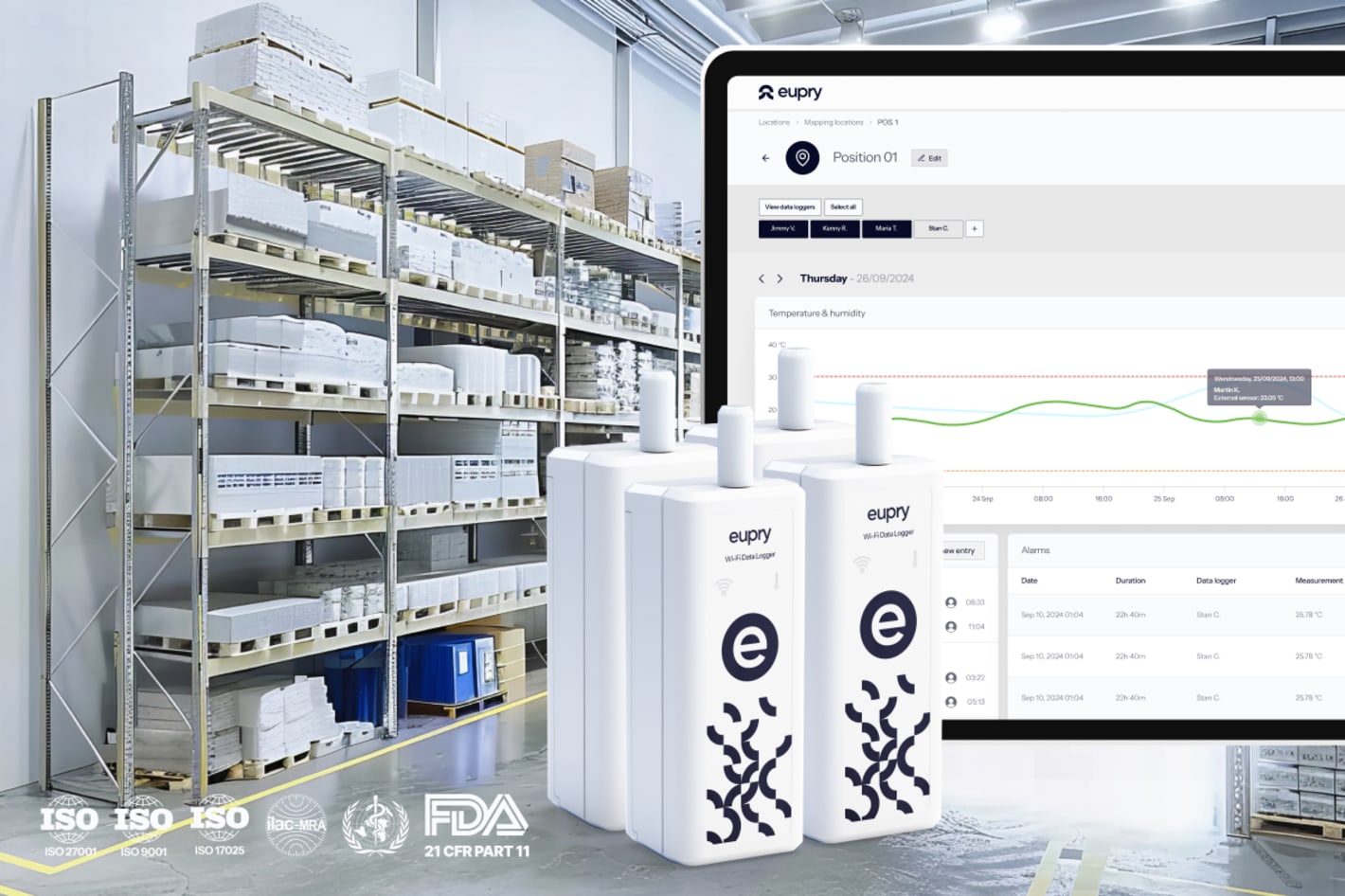Temperature compliance for pharmaceutical warehouses

Jakob Konradsen
GDP requirements and best practices
Pharmaceutical warehouses must protect product quality and patient safety while meeting Good Distribution Practice (GDP) expectations for temperature compliance. This guide shows how to build a risk‑based program that links temperature mapping, monitoring, calibration, and documentation into one compliant flow – and how to harmonize it across multiple sites.
Get an actionable, audit‑ready, 13-step list that covers scope, risk assessment, mapping, monitoring, calibration, and records.

What are the GDP requirements for pharmaceutical warehouse compliance?
Regulators expect you to demonstrate that storage areas consistently maintain labelled conditions and that you can prove it with a qualified process. In practice, that means initial qualification and temperature mapping before use, monitoring placed according to mapping results, risk‑based requalification, and complete, retrievable records. Align local expectations with your QMS and product risk. Reference EU GDP 2013/C 343/01 and USP <1079.4> for detailed requirements.
- Mapping before use: Qualify storage areas under representative conditions and document acceptance criteria in advance.
- Monitoring follows mapping: Place permanent sensors at identified hot and cold spots and representative areas.
- Risk‑based repeats: Re‑map or requalify after change, adverse trends, or as indicated by seasonal risk.
- Records and data integrity: Keep versioned protocols, reports, calibration certificates, and audit‑ready monitoring data.
Also read: Pharmaceutical warehouse temperature mapping: Step‑by‑step GDP guide
Scoping a pharmaceutical warehouse for GDP compliance
Clarity on scope prevents gaps and audit findings. Define which buildings and zones are in scope, the labelled storage ranges you must maintain, and any GMP interfaces if the warehouse sits on a manufacturing site. Confirm national expectations in addition to EU GDP and align responsibilities across quality, validation, and facilities.
- Scope and zones: Describe buildings, rooms, mezzanines, cages, and loading areas with target ranges.
- Products and ranges: List labelled storage conditions – for example 15–25 °C or 2–8 °C – and humidity if applicable.
- Interfaces and third parties: Identify GMP touchpoints and 3PL sites; document how controls are extended.
- Ownership and suppliers: Assign role owners and qualify mapping, monitoring, and HVAC service providers.
Risk‑based programs for pharmaceutical warehouse temperature compliance
A risk‑based program links a written risk assessment to mapping design, monitoring placement, alarm strategy, calibration intervals, and review cadence. Decisions are traceable to product risk, warehouse design, and data trends.
- Risk assessment: Evaluate layout, HVAC design, loading patterns, door activity, historical excursions, and seasons.
- Acceptance criteria: Define pass/fail limits and variability thresholds before executing mapping.
- Requalification triggers: Specify when to repeat mapping – for example after layout or HVAC change, capacity shifts, trend signals, or change control events.
- Continuous verification: Use continuous data to verify performance and reduce disruption where justified by risk.
Also read: Temperature mapping: Tips, frameworks, and pitfalls

Compliance checklist for pharmaceutical warehouses
Download a free temperatue compliance checklist for pharma warehouse. Get a step‑by‑step guide to help you qualify warehouses, execute mapping, set up monitoring, and document results in line with GDP expectations.
What is pharmaceutical warehouse temperature mapping?
Temperature mapping establishes the temperature distribution and identifies hot and cold spots for sensor placement. A robust protocol for warehouse mapping defines objectives, acceptance criteria, sensor count and placement, test scenarios, sampling rate, and reporting. Use calibrated equipment at relevant points and document any deviations.
- Protocol essentials: Objective, scope, acceptance criteria, responsibilities, safety, and report content.
- Sensor plan: Number and placement based on volume and risk; include likely extremes and representative locations.
- Test scenarios: Representative loading and door activity; consider door‑open tests and power interruption simulations.
- Seasonality: Justify whether seasonal extremes warrant additional studies for ambient‑range warehouses.
- Reporting: Analyze distribution and variability; conclude pass/fail and recommend permanent sensor locations.
For more detail, see the guide: Pharmaceutical warehouse temperature mapping: Step‑by‑step GDP guide.
How does pharmaceutical warehouse monitoring support GDP compliance?
Monitoring should reflect the mapping results and your product risk. Place permanent sensors at identified extremes and representative areas, define alarm thresholds and responsibilities, and review trends. Keep data complete, time‑synchronized, and retrievable with an audit trail.
Also read: How to make your temperature monitoring audit‑ready
- Sensor placement: Use mapping to guide final positions at warmest, coldest, and representative points.
- Alarm strategy: Set thresholds, responsibilities, escalation, and documentation to limit insignificant alarms.
- Trend review: Review alarms and trends at a defined cadence; refine limits and placement when justified by data.
- Data integrity: Ensure secure records, backups, and access control; maintain calibration references to each device.
For more details, see the dedicated guide: Pharmaceutical warehouse monitoring: how to stay GDP compliant
Calibration and data integrity in pharmaceutical warehouses
[Calibration]/temperature-calibration) maintains trust in results over time. Use calibration services traceable to national or international standards and at temperatures aligned to intended use. Link certificates to device IDs and locations. For electronic records, ensure your system supports audit trails, time synchronization, backups, and controlled access.
- Calibration intervals: Set based on risk, manufacturer guidance, and data drift history.
- Certificate management: Store valid certificates and link them to assets and locations.
- Traceability: Ensure calibration certificates are traceable to national or international standards.
- Electronic records: Maintain audit trails, backups, and user access controls for monitoring and mapping data.
Scaling GDP compliance across multiple pharmaceutical warehouses
Multi‑site programs need harmonized SOPs, shared templates, and central visibility. Standardize mapping protocols, acceptance criteria, and alarm strategies, then manage exceptions by risk. Use a central system to view status, trends, and audit‑ready reports across sites.
- Harmonized templates: Standardize protocols, reports, and SOPs to speed approvals and reduce errors.
- Central oversight: Use dashboards to review alarms, trends, and calibration status across sites.
- Change control: Apply consistent change control so layout or HVAC updates trigger the right studies.
Also read: Continuous temperature mapping – eliminate re‑mappings with Eupry
CEIV and GDP requirements for logistics warehouses
Air cargo and logistics hubs face short dwell times and frequent handovers. Align warehouse controls with GDP while meeting [IATA CEIV](/regulations-temperature-compliance/ceiv/) Pharma program expectations where applicable. Focus on handover documentation, alarm ownership, and rapid retrieval of monitoring data during audits or route qualification.
- Handover control: Define responsibilities and records at receipt and dispatch.
- Alarm ownership: Clarify who investigates alarms during dwell periods and how findings are shared.
- Route qualification: Link warehouse mapping and monitoring evidence to route or lane documentation.
Also read: How to efficiently achieve your CEIV pharma certification
Common pitfalls in GDP warehouse compliance and how to avoid them
Even mature teams hit the same stumbling blocks. Use the list below to anticipate issues and reduce rework.
- Missing acceptance criteria: Define pass/fail limits and variability thresholds before any test begins.
- Seasonal blind spots: Assess whether ambient warehouses need targeted summer or winter studies.
- Monitoring not tied to mapping: Place permanent sensors based on hot and cold spots, not convenience.
- Weak alarm strategy: Reduce insignificant alarms with clear thresholds, roles, and escalation.
- Incomplete records: Keep a master index for protocols, reports, calibration certificates, deviations, and CAPAs.
Also read: Data logger calculator for mapping: How many do you need for your warehouse?
Training and competency for GDP warehouse compliance
Personnel must be trained and competent for their roles in mapping, monitoring, calibration, and documentation. GDP 2.2 highlights the importance of training and role‑appropriate competency. Provide training tailored to responsibilities, verify understanding where required, and maintain complete training matrices and certificates as evidence.
13 steps for GDP temperature compliance for pharma warehouses
Get audit‑ready, save time, reduce risk, and standardize your approach across sites with this blueprint designed for GDP- and pharma compliance in warehouses.

FAQ: Temperature compliance for pharmaceutical warehouse and GDP
Digital temperature compliance solutions for pharma warehouses
One solution, all you need for thermal compliance
Eupry brings temperature compliance – mapping, monitoring and calibration – into one digital, GxP-compliant solution.
Ensure compliance of your pharma warehouse and any other facility and gain quality control across sites in less time, at a lower cost, only using one vendor.
- Full digital overview and audit reports in 3 clicks
- Automated monitoring in real-time
- On-site and remote mapping solutions built for GxP
- The fastest calibration on the market


